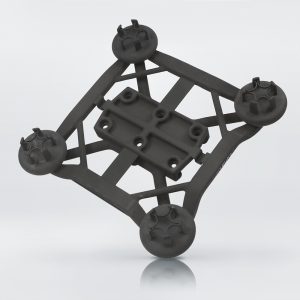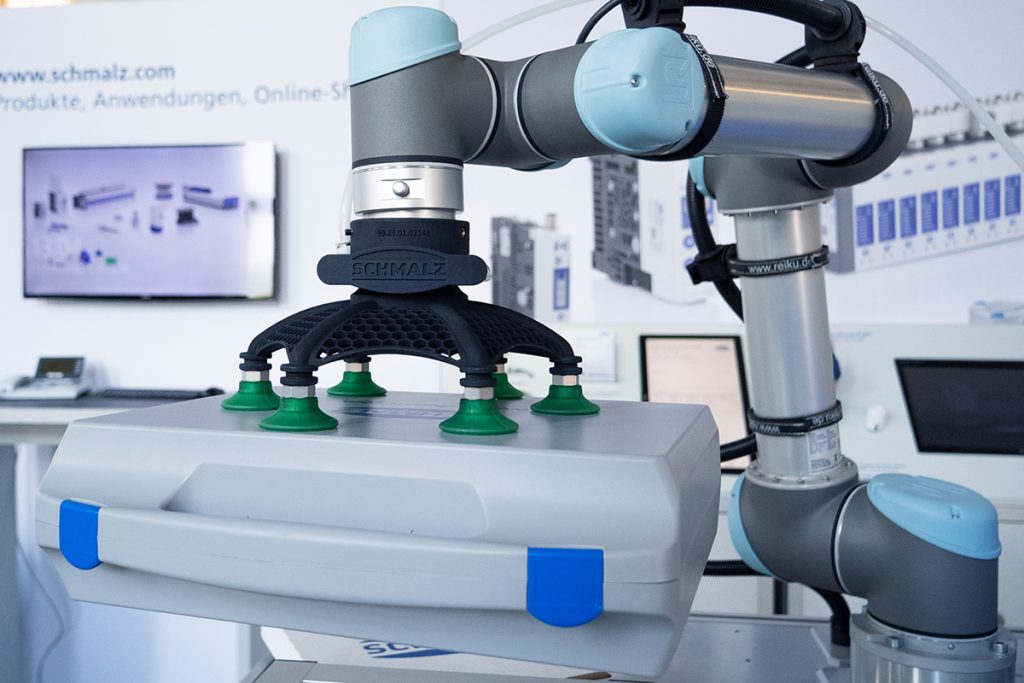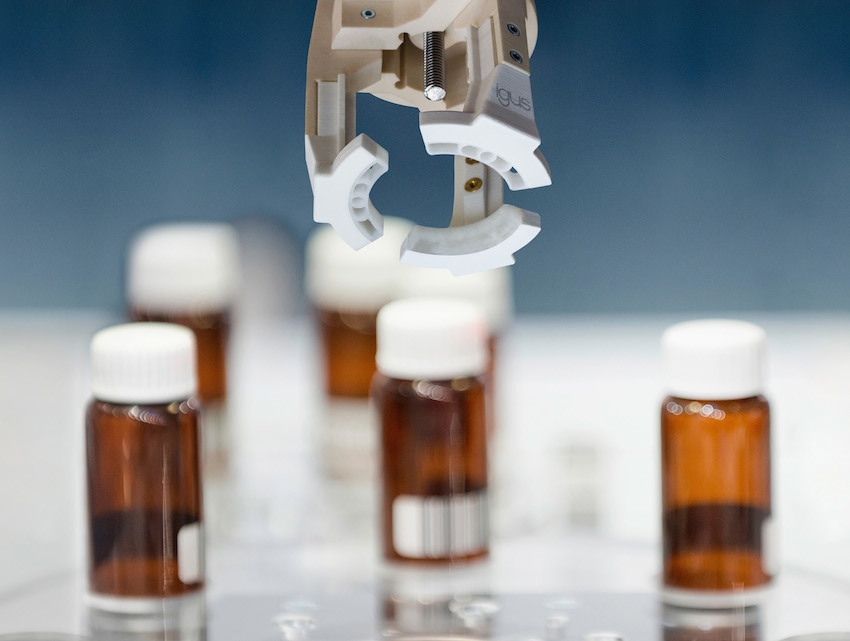[Image credit: Schmalz]
3D printing is one of the central technologies advancing the capabilities of industrial robotics. It enables greater design freedom, lower cost and shorter lead time in producing custom grippers and end effectors for robotic applications.
And with customisation being a new norm in robotics and automation, 3D printing provides a solution for cost-effective custom grippers, without huge investments in moulds or CNC machining.
Below, we dive into the benefits of 3D printing for grippers and how different companies are using the technology to create advanced gripper designs and achieve faster and cheaper production.
Take a look at the other applications covered in this series:
3D Printing for Heat Exchangers
3D Printing for Bearings
3D Printing for Bike Manufacturing
3D Printing for Digital Dentistry & Clear Aligner Manufacturing
3D Printing for Medical Implants
3D-Printed Rockets and the Future of Spacecraft Manufacturing
3D Printing for Footwear Manufacturing
3D Printing for Electronic Components
3D Printing in the Rail Industry
3D-Printed Eyewear
3D Printing for End-Part Production
3D printing for Brackets
3D Printing for Turbine Parts
How 3D Printing Enables Better-Performing Hydraulic Components
How 3D Printing Supports Innovation in the Nuclear Power Industry
3D Printing for Aircraft Cabins
3D printing and the evolution of robotic grippers
With the growing use of robots in manufacturing, robotic grippers – essentially robot arms – are evolving to meet the needs of advanced applications in the automotive, electronics and food processing industries.
This evolution has led to the development of lighter, customised robotic grippers with increased load capacity and safety features.
Meeting the needs of advanced grippers, however, is becoming increasingly challenging for traditional manufacturing technologies. Because of the economies of scale, traditional manufacturing can be too expensive when a company needs only a small batch of grippers.
On top of that, customisation of grippers proves difficult and costly to achieve with conventional technologies, like injection moulding.
3D printing, thanks to its flexibility and speed, opens new possibilities for the manufacturing of grippers.
The benefits of 3D-printed grippers
Lightweighting
With robots becoming smaller, designing smaller, lighter grippers to fit onto such robots has become a priority for many manufacturers. One way 3D printing can help is by producing grippers that can do more while weighing less.
With 3D printing, manufacturers can design new shapes and geometries that require less material and can use lightweight materials, like carbon fibre, to further cut down on the gripper’s weight.
While 3D printing allows for weight reduction, it also enables the design of the grippers with the same or higher load capacity. Lighter weight, coupled with improved load capacity, means faster movements of a robot and shorter cycle times, which are the key objectives of the users of robotic technology.
Customisation
Modern robots are increasingly used to improve efficiencies in a high-mix, low-volume environment where there is a high level of customisation. Often there are no fitting standard solutions available on the market so, for many applications, robotic grippers will have to be custom designed.
3D printing is an ideal technology for customising robotic grippers. Companies don’t need to invest in expensive custom tooling – instead, they can create individual designs and produce them directly on a 3D printer. It also means that 3D printing of custom grippers is more economical because there are no added tooling costs.
Part consolidation
3D printing makes it possible to produce grippers that were previously made up of multiple parts, as a single component. This ability to consolidate several parts into one results in cheaper and faster production and also means there are fewer separate parts to be assembled.
Safety
The safety of robotic grippers is another element that can be improved with 3D printing. As collaborative robots become more popular, it’s crucial to design robotic grippers that are safe to use alongside human co-workers.
Design flexibility afforded by 3D printing makes it easy to design a rounded housing for grippers with no sharp corners, which can be difficult for conventional processes. Furthermore, it enables engineers to test multiple designs, quickly and inexpensively, to ensure maximum safety of the gripper.
5 Examples of 3D printing for robotic grippers
1. An 86 per cent lighter gripper
Describing the benefits of 3D-printed grippers is one thing but exploring how the technology is used in real-life applications is quite another. For example, 3D printing specialist, Kuhn-Stoff GmbH & Co KG, has proved that 3D printing can reduce gripper weight by 86 per cent and manufacturing costs by up to 50 per cent.
The company used polymer Powder Bed Fusion (PBF) technology to produce a lightweight, yet durable, bronchial gripper for Wittmann Robot Systeme GmbH. PBF technology uses a laser to melt and fuse layers of polymer powder to create an object.

[Image credit: EOS]
The gripper was previously made from aluminium, rubber tubes and multiple connecting elements, resulting in high production costs. By redesigning the gripper for 3D printing, the Kuhn-Stoff team was able to reduce the number of components from 21 to 2 and 3D printed them in nylon material.
Fewer components mean less material is needed for production, making 3D printing a faster and cheaper process.
Adding to these benefits is the ability to integrate pneumatic ducts and connectors into the base plate.
The 3D-printed gripper has proven durable too. Kuhn-Stoff reports it has been tested through five million cycles, with zero failures or defects detected.
2. IAM 3D Hub 3D prints a robotic gripper for automotive production applications
Another example illustrating the flexibility of 3D printing comes from the Spanish digital innovation hub, IAM 3D Hub, which used the technology to improve the functionality of grippers.
Conventional grippers are extremely complex systems, featuring a large number of components. This can lead to higher acquisition costs, while also increasing the risk of failure, due to a need for additional maintenance and ongoing, constant adjustment.
That’s why IAM 3D Hub set out on a journey to reduce this complexity through 3D printing.

[Image credit: HP]
Producing the grippers additively, using HP Multi Jet Fusion technology, helped the IAM 3D Hub’s team reduce the number of parts in each gripper, including conduits, connectors, magnets and other elements, by more than 80 per cent, while simultaneously reducing the space required for the system to operate.
By redesigning the coupling mechanism, the new gripper also facilitates a faster connection with the robot, reducing the process and installation time by 40 per cent.
3. Schmalz customises grippers with 3D printing and software
The German company, Schmalz, began its reach into the world of vacuum and gripping technology more than 30 years ago. In its journey to becoming a leader in the sector, the company adopted 3D printing for product development and small series production.

[Image credit: Schmalz]
The team at Schmalz understood that, as automation increasingly impacts the production environment, new and unique handling applications require new individual gripping devices. As a result, a one-size-fits-all gripper can’t meet the requirements of different automation applications perfectly.
This realisation has led to the development of a system that enables quick and easy design of custom grippers. Through the partnership with software company, Trinckle 3D, Schmalz has developed an app that allows its customers to customise vacuum grippers.
The entire configuration of the use-case-specific gripper reportedly takes about 10 minutes and does not require any expertise in classic CAD software or 3D printable design.
3D printing technology is the key to cost-efficient and fast production of designs generated by Schmalz’s app. For example, the new grippers reduce handling interference by incorporating air guidance into the gripper design.
In this way, Schmalz produces lightweight, robust, and more importantly, customised, grippers in a short time. Attached to lightweight robots and cobots, the Schmalz solution can hold loads of up to 10 kilograms.
4. A 3D-printed gripper speeds up packaging line change-overs

[Image credit: Igus]
Packaging lines must be flexible, especially when there are frequent product change-overs. Achieving this flexibility, however, is often easier said than done. In some cases, a product change-over process can take several days, until a new, suitable gripper is made.
Carecos Kosmetic GmbH is one company that faced this challenge and found a solution in 3D printing.
During change-overs, the company needed new grippers made for the packaging machines which would grip the lids and screw them onto jars. Traditionally, the company would machine the grippers from aluminium, which cost up to 10,000 euros per part and took about six weeks to manufacture.
Considering such a long lead time, the company searched for an alternative solution that could produce the grippers faster.
Carecos Kosmetic turned to material extrusion 3D printing and was able to produce a gripper within 12 hours. The company also saved up to 85 per cent of the cost and 70 per cent of the manufacturing time by switching to polymer 3D printing. As an additional bonus, the printed plastic grippers are also seven times lighter than metal counterparts.
5. 3D printing for soft robotic grippers

Silicone 3D-printed soft grippers [Image credit: ACEO]
Soft robotics is a field of robotics that uses flexible materials, like TPU and silicone, to create lightweight and elastic grippers.
For soft robotic grippers, 3D printing provides a unique combination of design freedom, soft materials and small series. One company that has developed expertise in this field is ACEO, a division of the German chemical giant, Wacker Chemie AG.
ACEO has developed a silicone 3D printing technology that uses a ‘drop-on-demand’ technique, similar to inkjet 3D printing. The process starts by depositing droplets of the material in the shape of a single part layer, which is then cured with UV light. The next layer of silicone droplets is then applied, and the UV light bonds it to the previous one. The process is repeated until the object is complete.
German start-up, Formhand, has developed a universal gripper for multi-purpose applications across industries, using ACEO’s silicone 3D printing. The team used ACEO’s service to prototype several gripper designs. Thanks to the technology, they were able to create custom components quickly and at low cost.
Looking more broadly, 3D printing of soft robotic grippers paves the way for the miniaturisation of grippers and multi-material designs. In future, such systems can be used in jet engine maintenance and minimally invasive surgery.
Taking robotic grippers to the next level with 3D printing
As the need for more versatile robotic grippers grows, 3D printing provides a solution that delivers dexterous, lightweight, custom grippers. Such grippers are cheaper and faster to produce, which gives manufacturers more flexibility to experiment with designs and integrate added functionality.
Crucially, 3D-printed grippers add value to the overall robotic system, helping to make robots lighter and smaller.
The evolution of robotic gripping technology will surely continue, given recent trends of smart, digitally-driven manufacturing, and 3D printing will be the go-to method of taking gripper designs to the next level.



